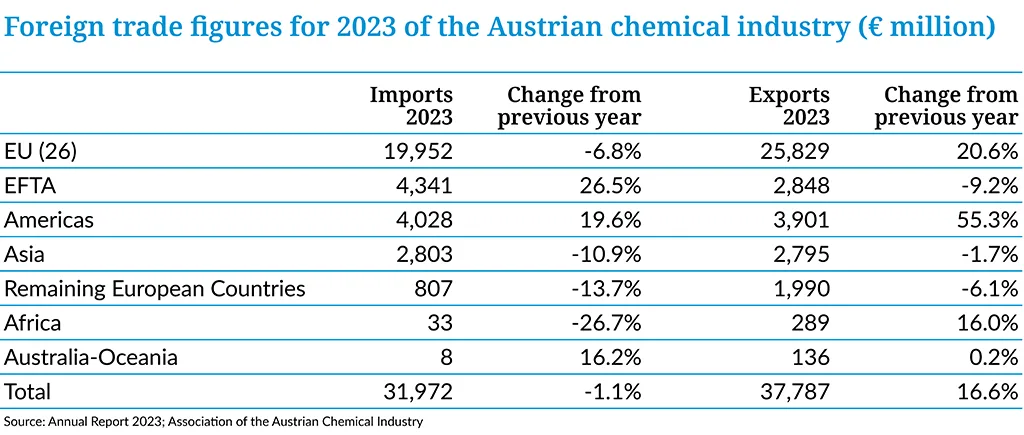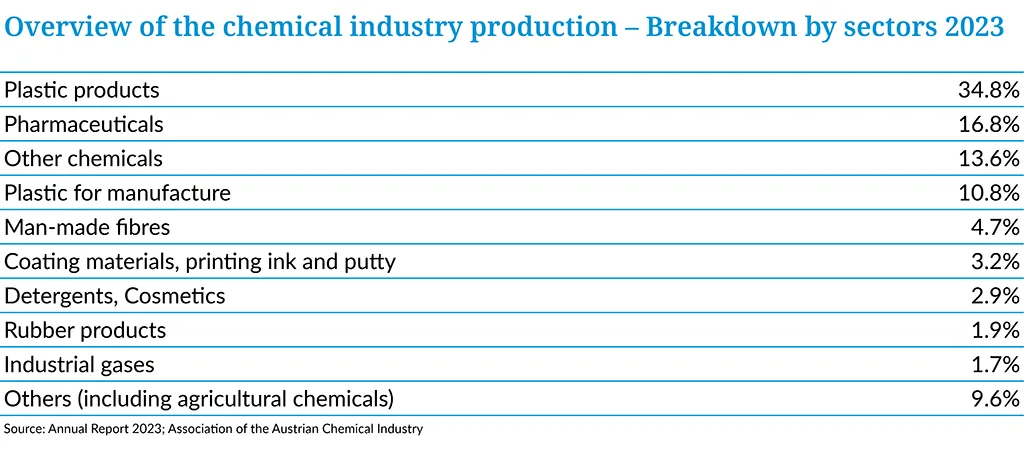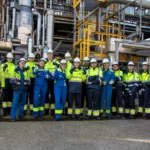Chemical industry snapshot
Fourth largest industrial sector in Austria
Chemicals are the fourth largest industrial sector in Austria, generating about 15,4% of industrial added value. The industry provides about 11,3% of total Austrian industrial employment, 14,5% of R&D expenditure and 12,8% of industrial spending on environmental protection. z
Massive decline in production in 2023
The Austrian chemical industry had to face a difficult year with no upturn in sight. Production dropped by 10,4% to a volume of 18,4 billion Euros. While pharmaceuticals were able to grow by about 15%, all other sectors were affected by the economic downturn.
A sector dominated by mid-sized companies
In 2023 the chemical sector comprised 231 companies employing 49 429 people which means a slight decline of -1,4%. Only 56 companies have more than 250 employees. Chemical companies are distributed across Austria, with key clusters in Upper Austria near Linz and in the Vienna region.
Investment has fluctuated but the trend is down
Plastics (raw materials and products) were more than 45% of production by value in 2023, followed by pharmaceuticals (16,8%) and chemicals (13,6%). Agrochemicals were 3,2%. Over the last ten years, investment in the chemical industry has fluctuated widely and peaked in 2019 and has still not reached pre-crisis level.



How are we doing?
Strengths
- High level of innovation
- High level of specialization
- High level of networking among producers, suppliers and service providers
- Social stability
- Well-educated and trained labour force
- Strategic location at the centre of Europe
Challenges
- Increases in labour costs in recent years
- Demographic trends
- High energy costs
- High administrative and regulatory burden
Our contribution to a competitive Europe
The Government Programme is strongly oriented towards the European Green Deal and is even more ambitious in the field on climate policy with the target to become climate neutral by 2040. Hence, the Austrian chemical industry puts special emphasis on R&D and innovation in this area of high political interest.
The high level of innovation in the chemical industry is partly due to the very positive overall framework for R&D, especially due to its tax incentives for research and development. The research tax credit is a best practice model and not only helps to fund human resources via investments but also buildings, research facilities and technologies. There is no maximum financial limit. The research tax credit in Austria applies to fourteen percent of the total investment volume.
In line with the ambitious climate neutrality target Austria’s recovery and resilience plan devotes 59% of the plan’s total allocation to measures that support climate objectives. This includes reforms to Austria’s tax system that target reducing CO2 emissions through incentives for climate friendly technologies, preferential tax rates for low- or zero- emission products, and pricing of CO2 emissions. Other measures invest in energy efficiency, renewables, decarbonisation of industry, biodiversity and circular economy – all of them of considerable relevance for the chemical industry.
Digital transition and life sciences are two more focus areas of the Government which should create additional opportunities for the sector and promote investments.














